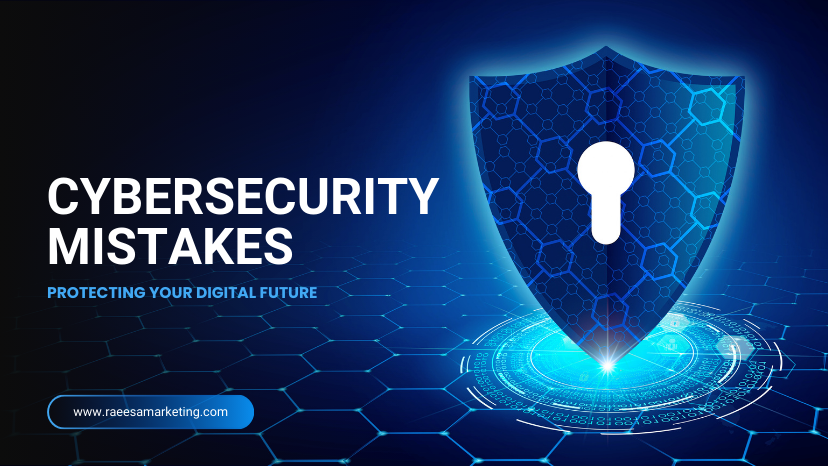
10 Common Cybersecurity Mistakes Everyone Makes (And How to Avoid Them)

10 Common Cybersecurity Mistakes (and How to Avoid Them)
Cybersecurity is no longer just an IT problem — it’s a daily reality for individuals and businesses alike. With cyberattacks increasing by 38% in 2022 (according to Check Point Research), protecting your personal and professional data has never been more important.
Yet, many people continue to make avoidable mistakes that leave them vulnerable to hackers, identity theft, and data breaches. In this guide, we’ll explore 10 of the most common cybersecurity mistakes, why they matter, and how you can fix them starting today.
1. Using Weak Passwords
“123456” and “password” still rank among the world’s most commonly used passwords (NordPass, 2023). Weak passwords are like leaving your digital front door unlocked — hackers can crack them in seconds using brute-force software.
Why it matters: A compromised password often leads to stolen accounts, financial fraud, or identity theft.
The fix:
- Use a password that is at least 12–16 characters long.
- Mix uppercase, lowercase, numbers, and symbols.
- Use a password manager like 1Password, Bitwarden, or LastPass to generate and securely store unique passwords.
2. Reusing the Same Password Everywhere
Many people reuse the same password across multiple accounts for convenience. Unfortunately, once one account is hacked, attackers can try that password on all your other accounts — a tactic known as “credential stuffing.”
Why it matters: If your email password is leaked, hackers can use it to access your banking, shopping, or work accounts.
The fix:
- Never reuse passwords across accounts.
- Password managers can automatically create and fill strong, unique passwords for every login.
- Enable alerts for password breaches on services like Have I Been Pwned.
3. Ignoring Software Updates
Outdated software and operating systems often contain known vulnerabilities. Hackers actively scan for devices that haven’t been patched.
Example: The 2017 WannaCry ransomware attack exploited outdated versions of Windows, infecting over 200,000 computers worldwide.
The fix:
- Turn on automatic updates for your OS, browsers, and apps.
- Regularly update plugins and extensions.
- If a product no longer receives updates, consider upgrading or replacing it.
4. Clicking on Phishing Links
Phishing remains one of the most successful cyberattack methods. Fraudulent emails and websites trick you into entering sensitive data or downloading malware.
Red flags to watch for:
- Urgent language like “Your account will be suspended!”
- Mismatched email addresses (e.g., support@paypa1.com).
- Suspicious attachments or links.
The fix:
- Always hover over links before clicking.
- Verify the sender’s domain carefully.
- Consider using a secure email provider or anti-phishing browser extension.
5. Using Public Wi-Fi Without Protection
Free Wi-Fi at cafes, airports, or hotels is convenient but unsafe. Hackers can intercept your browsing activity, including logins and payment information.
The fix:
- Use a VPN (Virtual Private Network) to encrypt your connection. Providers like NordVPN or ExpressVPN are reliable.
- Avoid accessing banking or sensitive accounts on public Wi-Fi.
- Use your phone’s personal hotspot as a safer alternative.
6. Not Backing Up Data
Data loss isn’t just about accidental deletion — ransomware attacks can lock your files forever unless you pay the attacker.
The fix:
- Maintain regular backups (daily or weekly).
- Use a cloud backup solution like Google Drive, iCloud, or Dropbox.
- Keep a local backup on an encrypted external hard drive.
7. Oversharing on Social Media
Sharing too much personal information online gives cybercriminals the clues they need to guess your security answers or craft convincing phishing attacks.
Example: If your Facebook bio lists your pet’s name and your birthday, hackers already know two common password hints.
The fix:
- Limit personal details (location, birthdays, etc.) on public profiles.
- Review your privacy settings.
- Think twice before posting travel plans or sensitive updates.
8. Not Using Two-Factor Authentication (2FA)
A password alone is no longer enough. With 2FA, even if your password is stolen, hackers would also need a second factor (like a phone code or biometric).
The fix:
- Enable 2FA on email, banking, and social media accounts.
- Use an authenticator app (Google Authenticator, Authy) instead of SMS, which can be hijacked through SIM-swapping.
9. Downloading Cracked or Pirated Software
Pirated software often comes bundled with malware or spyware that can steal your data.
The fix:
- Only download apps from official sources (Apple App Store, Google Play, vendor websites).
- If cost is a concern, look for open-source or free alternatives.
10. Thinking “It Won’t Happen to Me”
The biggest mistake is assuming cyberattacks only target large companies. In reality, small businesses and individuals are often the easiest targets because of weak defenses.
The fix:
- Stay cautious and proactive.
- Educate yourself on new threats.
- Treat cybersecurity as an ongoing habit, not a one-time setup.
Conclusion
Cybersecurity is not optional — it’s essential. By avoiding these 10 common mistakes, you instantly improve your digital safety and reduce your chances of being hacked.
Remember: online security is about awareness + habits.
Start small today, and your future self will thank you.
FAQs About Cybersecurity Mistakes
Q1. What’s the number one cybersecurity mistake people make?
Weak and reused passwords remain the most common entry point for hackers.
Q2. Do I really need a VPN?
Yes, especially when traveling or using public Wi-Fi. A VPN encrypts your traffic and keeps your data safe.
Q3. Is antivirus software still necessary?
Yes. Modern antivirus tools not only block malware but also phishing sites and ransomware.
Q4. How often should I back up my data?
At least once a week — daily if you handle critical or business data.